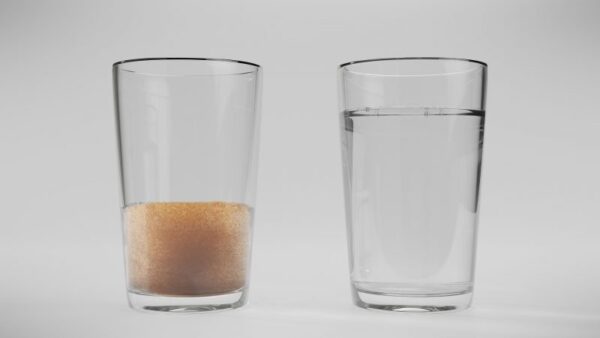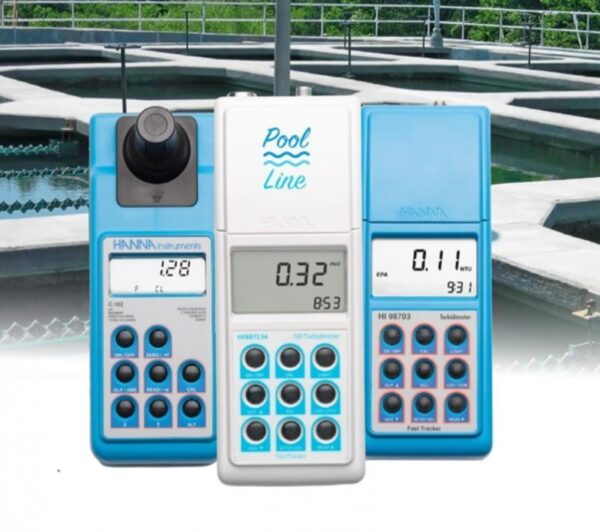Measuring Turbidity in Drinking water
Turbidity is one of the most common and intuitive qualities of water. The first thing we notice about water is how cloudy it is (or isn’t). However, behind the cloudiness lies some important implications. Turbidity can affect everything from how water is disinfected to the quality of our lakes, oceans, and streams.
At its simplest form, turbidity is just the cloudiness of water. The cloudiness typically comes from particles that are suspended in the water that we can’t see individually. These particles could be algae, dirt, minerals, proteins, oils, or even bacteria.
Turbidity is an optical measurement that indicates the presence of suspended particles. It’s measured by shining light through a sample, and quantifying the suspended particle concentration. The more particles that are in a solution, the higher the turbidity.
It’s important to note that while turbidity correlates with suspended solids, measuring turbidity is not the same as measuring total suspended solids (TSS). TSS measurements are gravimetric, which quantifies the mass of the solids suspended in a sample, performed by weighing the separated solids.
Importance of Turbidity

Turbidity is a benchmark water quality parameter across all environments, from the municipal drinking water facility to environmental monitoring.
The primary goal of drinking water treatment is to remove and reduce turbidity. Throughout the treatment process, turbidity is measured at multiple stages to determine treatment efficiency and to ensure compliance with government regulations. Suspended matter (soil, algae, etc.) in water reduces effectiveness of disinfecting chemicals and can act as carriers for bacteria and parasites.
These suspended particles are indicated by water that appears slightly cloudy and has a high turbidity value. Even without turbidity reducing the effectiveness of chlorination, overall water clarity is an indicator of quality, reassuring the consumer of its safety. After all, nobody wants to drink cloudy water from the tap!
Turbidity has wide-reaching importance in environmental monitoring, where the cloudiness of water can indicate pollution. For example, after storm events the runoff from agriculture, logging, and construction sites can rapidly flood natural waters with sediment. This can disrupt aquatic life that dwells on the bottom of the water, which would require dredging to remediate.
The impact of construction sites is so significant that construction sites are required to monitor turbidity after major storm events to ensure that they comply with their permits.
Outside of drinking water, wastewater, and environmental use, measuring turbidity is useful in wineries or breweries, as well as other places across the food and beverage industry.
How is Turbidity Measured?

There are many methods to measure turbidity. As a measurement of how cloudy water is, we can use everything from visual methods to full-scale meters to quantify it.
Some visual methods are ideal for quick field environmental use, such as the Secchi disk. This consists of a disk that is lowered into water until it’s no longer visible. The depth at which the disk is not visible is the Secchi depth. This method is subjective and works best in slow-moving, low turbidity natural waters.
The best way to measure turbidity in a wide variety of samples is with a nephelometer, also known as a turbidity meter. Turbidity meters utilize a light and photo detector to measure light scatter, and read out in units of turbidity, such as nephelometric turbidity units (NTU) or formazin turbidity units (FTU).

It is generally required (check your local regulations) that 95% of drinking water in a one-month period have a turbidity reading of less than 0.5 NTU, and that no samples exceed 5 NTU at any given time.
Choosing a right Turbidity Meter:
– Laboratory bench meter
– Portable meter
– field measurement with turbidity probe (HI9829)
Turbidity meters are devices that have a light source, lens, and detector located 90° from the light source that work together to measure the turbidity of a sample. When a sample of is placed into the path between the light source and detector, some of the particles in the sample scatter the light in such a way that it reaches the detector at 90°. The detector determines the amount of light scattering and compares the reading against standards on a calibration curve.
Once you have your meter, taking turbidity measurements is easy and involves just a few simple steps:
- Calibrate the meter with standard cuvettes.
- Fill a cuvette with your sample.
- Clean the outside of the cuvette and if working with samples with very low turbidity, use silicone oil on the outside of the cuvette.
- Place the cuvette inside the meter and take your reading.
Turbidity Calibration Standards

The turbidity standards are an equally important portion of the measurement. Most modern turbidity standards are made from formazine, a synthetic polymer with a uniform particle size. The polymer is made from hydrazine and hexamethylenetetramine. The consistency of this compound has led to its adoption by nearly all standards organisations, such as ISO, EPA, and ASBC. A suspension of 1.25 mg/L hydrazine sulphate and 12.5 mg/L hexamethylenetetramine in water has a turbidity of one Formazin Turbidity Unit (FTU).
Most other turbidity units are based on FTUs, but vary based on the method they use. There are many different units, but here a few examples:
- Nephelometric Turbidity Units (NTU): Unit that is equal to FTU but measured using a turbidity meter design that complies with EPA standards.
- Nephelometric TurbidityRatio Unit (NTRU): EPA-based unit that uses the ratio method of determining turbidity.
- Formazin Nephelometric Units (FNU), equal to FTU but measured using ISO 7027 standards for the meter design
It’s important to decide which method you are likely to comply with when choosing a turbidity meter. Many different turbidity meter designs exist, but two are the most common: those that comply with EPA 180.1 and ones that comply with ISO 7027.
Laboratory QC:
HI88713 – ISO 7027 Compliant Benchtop Turbidity Meter

The HI88713 is a high accuracy benchtop turbidity meter. The meter is supplied complete with AMCO-AEPA-1 primary turbidity standards used for calibration and performance verification. The HI88713 meets and exceeds the requirements of the ISO 7027 Method for turbidimetric measurements.
- Ratio and non-ratio turbidity modes
- USB for data transfer

The HI88703 is a high accuracy (±2% of reading plus 0.02 NTU) Turbidity Benchtop Meter. The meter is supplied complete with AMCO-AEPA-1 primary turbidity standards used for calibration and performance verification. The HI88703 meets and exceeds the requirements of EPA Method 180.1 and Standard Methods for the Examination of Water and Wastewater 2130 B for turbidity measurements.

The HI83414 is a high accuracy EPA compliant turbidity meter and chlorine benchtop meter. This meter is a combination of a nephelometer and photometer to measure the most important parameters in drinking water: turbidity and chlorine. The meter is supplied complete with AMCO-AEPA-1 primary turbidity standards and NIST traceable secondary chlorine standards used for calibration and performance verification. The HI83414 meets and exceeds the requirements of EPA Method 180.1 and Standard Methods for the Examination of Water and Wastewater 2130 B for turbidity measurements. For chlorine measurements an adaptation of EPA Method 330.5 and Standard Method 4500-Cl G is used.
Field measurements:
There are 2 ways to bring you measurements to the field, using a portable turbidimeter and making a cuvette tests, or using a portable device like HI9829.

The HI9829 is a waterproof portable logging multiparameter meter that monitors up to 14 different water quality parameters. The microprocessor based multi-sensor probe allows for the measurement of key parameters including pH, ORP, conductivity, dissolved oxygen, turbidity, ammonium, chloride, nitrate, and temperature.
Choose your configuration!

The probe transmits readings digitally with options to log data while disconnected from the meter. An optional GPS provides location tracking of measurements. The complete system is simple to setup and easy to use. The HI9829 is highly customizable and supplied with all necessary accessories, packaged in a durable carrying case.
Turbidity range 0.0 to 99.9 FNU, 100 to 1000 FNU
Portable turbidity meters
All models are supplied with sample cuvettes and caps, calibration cuvettes standards sets, silicone oil, cuvette wiping cloth, batteries, AC adapter, instruction manual, and rugged carrying case.

The HI98703 is a high accuracy (±2% of reading plus 0.02 NTU) Turbidity Portable Meter. The meter is supplied complete with AMCO-AEPA-1 primary turbidity standards used for calibration and performance verification. The HI98703 meets and exceeds the requirements of EPA Method 180.1 and Standard Methods for the Examination of Water and Wastewater 2130 B for turbidity measurements.

The HI93414 is a high accuracy Turbidity and Chlorine Portable Meter. This meter is a combination of a nephelometer and photometer to measure the most important parameters in drinking water: turbidity and chlorine. The meter is supplied complete with AMCO-AEPA-1 primary turbidity standards and NIST traceable secondary chlorine standards used for calibration and performance verification. The HI93414 meets and exceeds the requirements of EPA Method 180.1 and Standard Methods for the Examination of Water and Wastewater 2130 B for turbidity measurements. The chlorine measurements are are adapted EPA Method 330.5 and Standard Method 4500-Cl G.
- Fast Tracker™ – Tag Identification System (T.I.S)
- USB for data transfer
- Operates on batteries or line voltage
Author: Nives Vinceković Budor, mag.ing.chem.ing.
Sources:
https://nzjz-split.hr/en/mutnoca-vode-i-zdravstveni-rizik/
https://www.who.int/water_sanitation_health/publications/turbidity-information-200217.pdf



